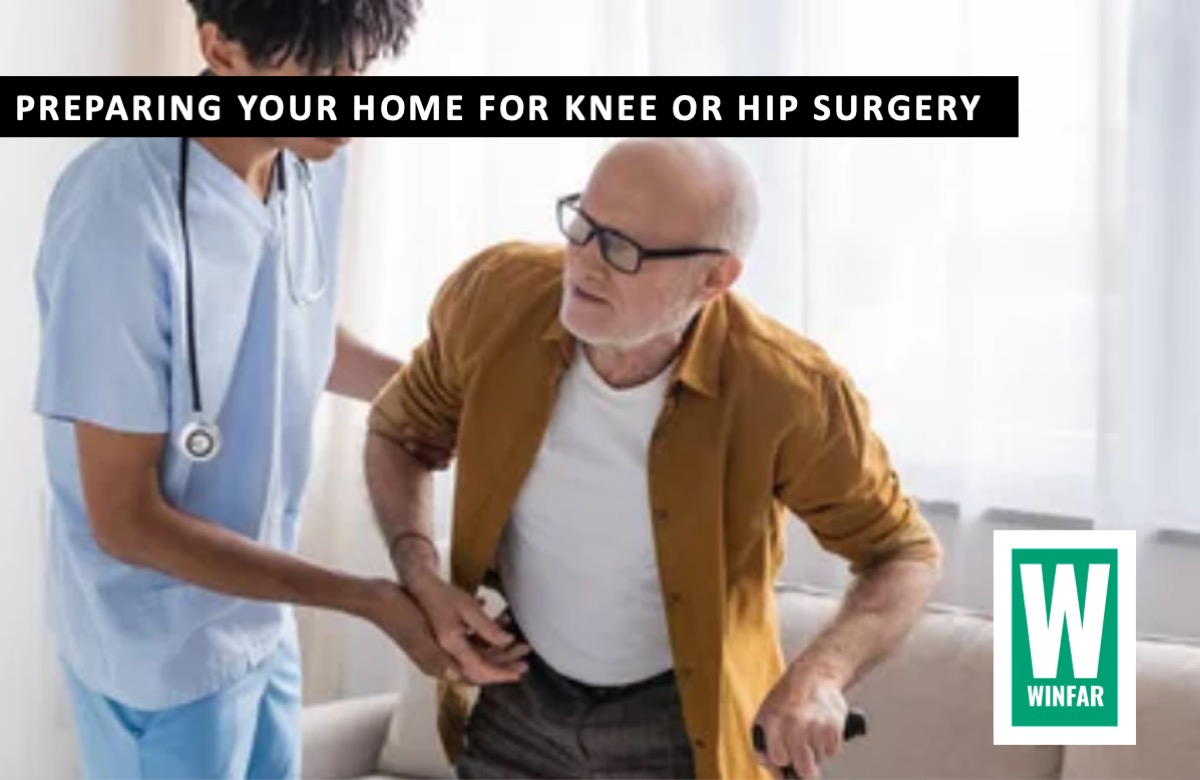Over time, many of us experience knee or hip pain, and physical therapy, pain-relief medication, minor surgery, or some combination of these provides relief. But for some, knee and hip problems become so intractable that a knee or hip replacement offers the best chance for a return to pain-free mobility.
Hip or knee surgery is a big deal. Full recovery times for replacement hips tend to be shorter than for replacement knees. Generally speaking, complete recovery for a hip replacement is 2-6 months. While a knee replacement is a bit more complicated, and can take anything from 3-12 months to heal.
When surgery is the only option available, you want to do everything possible to ensure as smooth, pain-free and expedient a healing process as possible. To do this, it’s crucial you prepare your home in advance, and create an environment that’s condusive to healing, that will speed up your recovery post-surgery as much as possible.
Important: Please consult your healthcare provider for guidance before preparing your living space. While these recommendations will go a long way to expediting the process, the nature of your operation may require a few additional specialist items and considerations not listed below.
SIMPLIFY YOUR ENVIRONMENT
- Make sure all essential items are easily accessible and on ground floor. You want to limit the use of stairs as much as possible.
- If possible, set up your bed on the ground floor.
- Opt for a low bed, with a harder mattress, that allows your feet to touch the floor when sitting on the edge.
- Make sure there’s a bathroom or a portable commode on the same floor as your primary living space.
- Stock up on canned or frozen food, toiletries, and other personal items.
- Prepare single meals that can be frozen and reheated for convenience.
- Organise your belongings to ensure everything is within easy reach. Avoid tiptoeing, reaching or bending.
- Place commonly used items between waist and shoulder level in cupboards.
- Keep glasses, teapot, and other frequently used items on the kitchen counter.
- Ensure easy access to your phone.
- Place chairs with firm backs in key rooms, such as the kitchen, bedroom, and bathroom, to provide seating during daily tasks.
- If using a walker, attach a sturdy bag or a small basket for essential items like your phone, notepad, pen, and other necessities.
ASSISTANCE AND ADDITIONAL TOOLS
If you anticipate needing help with daily activities like bathing, cooking, and running errands, arrange for a trained caregiver during the initial weeks post-surgery.
Also consider investing in the following useful additional tools:
- A Cane, crutches, or walker will help you feel more stable as you walk.
- An Easy Reacher for picking up items from the floor
- A commode or raised toilet seat
- Grab rails for stability. These can be placed as needed, anywhere in the home, providing stability and confidence when moving around, standing up, going to the bathroom, showering – and pretty much any activity.
- Sock aid for putting on socks
- Shoehorn with a long handle
IN THE BATHROOM
Bathroom safety is absolutely critical. Especially for Seniors. Bathrooms are dangerous places. They’re small, and cramped with lots of hard surfaces and corners. So, safety post-op is a non-negotiable. Post-op you will need some assistance in the bathroom.
- A raised toilet seat will make it easier for you to get on and off the toilet as the raised height prevents you from sitting too low, reducing pressure on the hips, especially important post-surgery. To this end consider an elevated toilet seat, a toilet safety frame OR a commode – a useful and versatile alternative that enables easy access when transferring from a bed, wheelchair or toilet. They are also height-adjustable, so they can be placed over a toilet. Or used as a standalone, next to the bed.
- Install safety bars (vertically or horizontally), around your toilet, bathtub or shower. This will not only increase your safety during transfers, but provide stability and confidence when moving around, standing up, going to the bathroom, showering – and pretty much any activity.
- Avoid using towel rails as grab bars. It’s dangerous. Towel rails are not designed to be weight bearing.
- Invest in a shower chair.
- Use non-slip mats around the bath/shower area for fall prevention.
- Keep the floor dry and place essential items within easy reach.
Recommended reading: BATHROOM SAFETY CHECKLIST FOR SENIORS
PREVENTING FALLS
Ensure your home is free from all potential tripping hazards:
- Remove loose wires, cords, and throw rugs.
- Address uneven flooring in doorways
- Ensure you have good lighting in bedrooms, bathrooms and walkways.
- Install night lights in dark hallways and rooms.
- Consider relocating small or mobile pets temporarily.
- Refrain from carrying items while walking; use a small backpack or fanny pack if necessary.
Recommended read: HOW TO CREATE A SENIOR-FRIENDLY KITCHEN
And lastly, practice using mobility aids such as canes, walkers, crutches, or wheelchairs in advance, focusing on correct techniques for various activities like sitting and standing from chairs, using the toilet, and navigating stairs. For more information as to HOW TO USE A CANE CORRECTLY or HOW TO USE A WALKER CORRECTLY read these related articles.

